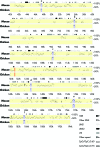Balanced translocation in a patient with craniosynostosis disrupts the SOX6 gene and an evolutionarily conserved non-transcribed region
- PMID: 16258006
- PMCID: PMC2564540
- DOI: 10.1136/jmg.2005.037820
Balanced translocation in a patient with craniosynostosis disrupts the SOX6 gene and an evolutionarily conserved non-transcribed region
Abstract
Craniosynostosis is a congenital developmental disorder involving premature fusion of cranial sutures, which results in an abnormal shape of the skull. Significant progress in understanding the molecular basis of this phenotype has been made for a small number of syndromic craniosynostosis forms. Nevertheless, in the majority of the approximately 100 craniosynostosis syndromes and in non-syndromic craniosynostosis the underlying gene defects and pathomechanisms are unknown. Here we report on a male infant presenting at birth with brachycephaly, proptosis, midfacial hypoplasia, and low set ears. Three dimensional cranial computer tomography showed fusion of the lambdoid sutures and distal part of the sagittal suture with a gaping anterior fontanelle. Mutations in the genes for FGFR2 and FGFR3 were excluded. Standard chromosome analysis revealed a de novo balanced translocation t(9;11)(q33;p15). The breakpoint on chromosome 11p15 disrupts the SOX6 gene, known to be involved in skeletal growth and differentiation processes. SOX6 mutation screening of another 104 craniosynostosis patients revealed one missense mutation leading to the exchange of a highly conserved amino acid (p.D68N) in a single patient and his reportedly healthy mother. The breakpoint on chromosome 9 is located in a region without any known or predicted genes but, interestingly, disrupts patches of evolutionarily highly conserved non-genic sequences and may thus led to dysregulation of flanking genes on chromosome 9 or 11 involved in skull vault development. The present case is one of the very rare reports of an apparently balanced translocation in a patient with syndromic craniosynostosis, and reveals novel candidate genes for craniosynostoses and cranial suture formation.
Conflict of interest statement
Competing interests: there are no competing interests
Similar articles
-
De Novo SOX6 Variants Cause a Neurodevelopmental Syndrome Associated with ADHD, Craniosynostosis, and Osteochondromas.Am J Hum Genet. 2020 Jun 4;106(6):830-845. doi: 10.1016/j.ajhg.2020.04.015. Epub 2020 May 21. Am J Hum Genet. 2020. PMID: 32442410 Free PMC article.
-
Cloning, characterization and chromosome mapping of the human SOX6 gene.Gene. 2001 Mar 7;265(1-2):157-64. doi: 10.1016/s0378-1119(01)00346-8. Gene. 2001. PMID: 11255018
-
Craniosynostosis as a clinical and diagnostic problem: molecular pathology and genetic counseling.J Appl Genet. 2018 May;59(2):133-147. doi: 10.1007/s13353-017-0423-4. Epub 2018 Feb 1. J Appl Genet. 2018. PMID: 29392564 Review.
-
Clinical and genetic characteristics of craniosynostosis in Hungary.Am J Med Genet A. 2015 Dec;167A(12):2985-91. doi: 10.1002/ajmg.a.37298. Epub 2015 Aug 20. Am J Med Genet A. 2015. PMID: 26289989
-
Craniosynostosis: genes and mechanisms.Hum Mol Genet. 1997;6(10):1647-56. doi: 10.1093/hmg/6.10.1647. Hum Mol Genet. 1997. PMID: 9300656 Review.
Cited by
-
Genetic advances in craniosynostosis.Am J Med Genet A. 2017 May;173(5):1406-1429. doi: 10.1002/ajmg.a.38159. Epub 2017 Feb 4. Am J Med Genet A. 2017. PMID: 28160402 Free PMC article. Review.
-
Genetic basis of single-suture synostoses: genes, chromosomes and clinical implications.Childs Nerv Syst. 2012 Sep;28(9):1301-10. doi: 10.1007/s00381-012-1781-1. Epub 2012 Aug 8. Childs Nerv Syst. 2012. PMID: 22872241 Review.
-
Immediate and long-term transcriptional response of hind muscle tissue to transient variation of incubation temperature in broilers.BMC Genomics. 2016 May 4;17:323. doi: 10.1186/s12864-016-2671-9. BMC Genomics. 2016. PMID: 27142659 Free PMC article.
-
FAD104, a regulatory factor of adipogenesis, acts as a novel regulator of calvarial bone formation.J Biol Chem. 2013 Nov 1;288(44):31772-83. doi: 10.1074/jbc.M113.452961. Epub 2013 Sep 19. J Biol Chem. 2013. PMID: 24052261 Free PMC article.
-
SOXopathies: Growing Family of Developmental Disorders Due to SOX Mutations.Trends Genet. 2019 Sep;35(9):658-671. doi: 10.1016/j.tig.2019.06.003. Epub 2019 Jul 6. Trends Genet. 2019. PMID: 31288943 Free PMC article. Review.
References
-
- Cohen M M.Epidemiology of craniosynostosis. New York: Oxford University Press, Inc, 2000
-
- Muenke M, Wilkie A.Craniosynostosis syndromes. vol 4: New York, McGraw‐Hill Companies, Inc. 2001
-
- Nah H. Suture biology: Lessons from molecular genetics of craniosynostosis syndromes. Clin Orthod Res 2000337–45. - PubMed
-
- Wirth J, Nothwang H G, van der Maarel S, Menzel C, Borck G, Lopez‐Pajares I, Brondum‐Nielsen K, Tommerup N, Bugge M, Ropers H H, Haaf T. Systematic characterisation of disease associated balanced chromosome rearrangements by FISH: cytogenetically and genetically anchored YACs identify microdeletions and candidate regions for mental retardation genes. J Med Genet 199936271–278. - PMC - PubMed
-
- Wuchner C, Hilbert K, Zabel B, Winterpacht A. Human fibroblast growth factor receptor 3 gene (FGFR3): genomic sequence and primer set information for gene analysis. Hum Genet 1997100215–219. - PubMed
Publication types
MeSH terms
Substances
LinkOut - more resources
Full Text Sources
Molecular Biology Databases
Miscellaneous





